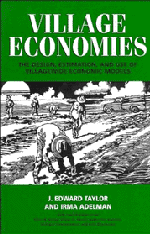Book contents
- Frontmatter
- Contents
- Acknowledgments
- 1 Introduction
- 2 Modeling village economies
- 3 The village economy and tenure security in West Africa: A Senegalese village SAM
- 4 Production and distribution in a dry-land village economy
- 5 Migration and the changing structure of a Mexican village economy
- 6 Economic linkages in a small regional economy: The case of Kutus Region, Kenya
- 7 Household nutrition and economic linkages: A village social accounting matrix for West Java, Indonesia
- 8 The village CGE: Basic model and estimation
- 9 Policy simulations
- 10 Conclusions
- Bibliography
- Index
5 - Migration and the changing structure of a Mexican village economy
Published online by Cambridge University Press: 05 June 2012
- Frontmatter
- Contents
- Acknowledgments
- 1 Introduction
- 2 Modeling village economies
- 3 The village economy and tenure security in West Africa: A Senegalese village SAM
- 4 Production and distribution in a dry-land village economy
- 5 Migration and the changing structure of a Mexican village economy
- 6 Economic linkages in a small regional economy: The case of Kutus Region, Kenya
- 7 Household nutrition and economic linkages: A village social accounting matrix for West Java, Indonesia
- 8 The village CGE: Basic model and estimation
- 9 Policy simulations
- 10 Conclusions
- Bibliography
- Index
Summary
Migration is tightly woven into the economic, cultural, and political fabric of communities on both sides of the Mexico–U.S. border. Nowhere is this more evident than in the economies from which migrants come. Official International Monetary Fund (IMF) estimates place total international migrant remittances to Mexico at $2.3 billion in 1989, an amount equal to 10 percent of Mexico's total merchandise exports, making migrants that country's major source of foreign exchange after oil and tourism (Russell and Teitelbaum, 1992). The activity of migration and the income migrants remit to their households of origin are a structural feature of village economies throughout Mexico. Because of this, a change in almost any aspect of economic policy in Mexico has implications for Mexico-to-U.S. migration. This fact has not been lost on policymakers in Mexico and in the United States, who fear that market reforms initiated in the 1980s and continuing in the 1990s will create new pressures for increased migration.
As migration links villages with the global economy, Mexico's rural economy is directly influenced by the international economic and political environment. Economic conditions in the United States, exchange rate devaluations, and changes in U.S. immigration policies can alter injections of migrant remittances into Mexico. Changes in remittances initially affect the households that receive them. The expenditure and production patterns of these households, however, quickly transmit impacts to other households. Secondand higher-order remittance effects generate villagewide “remittance multipliers,” which may be large relative to the initial injection of remittances (Adelman, Taylor, and Vogel, 1988).
- Type
- Chapter
- Information
- Village EconomiesThe Design, Estimation, and Use of Villagewide Economic Models, pp. 101 - 121Publisher: Cambridge University PressPrint publication year: 1996
- 1
- Cited by



